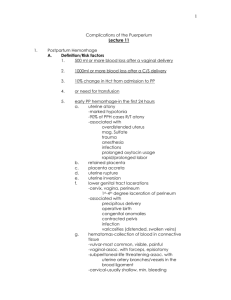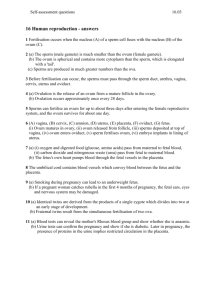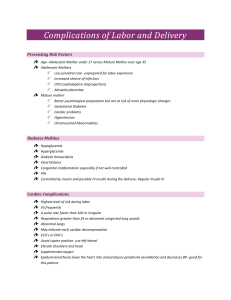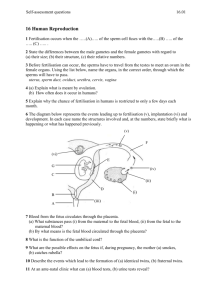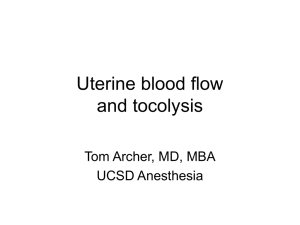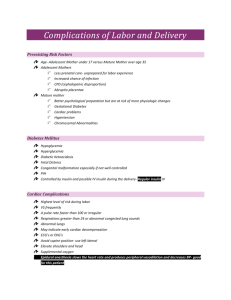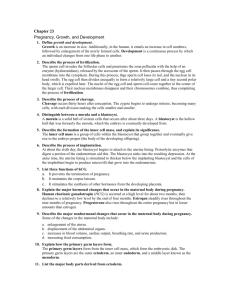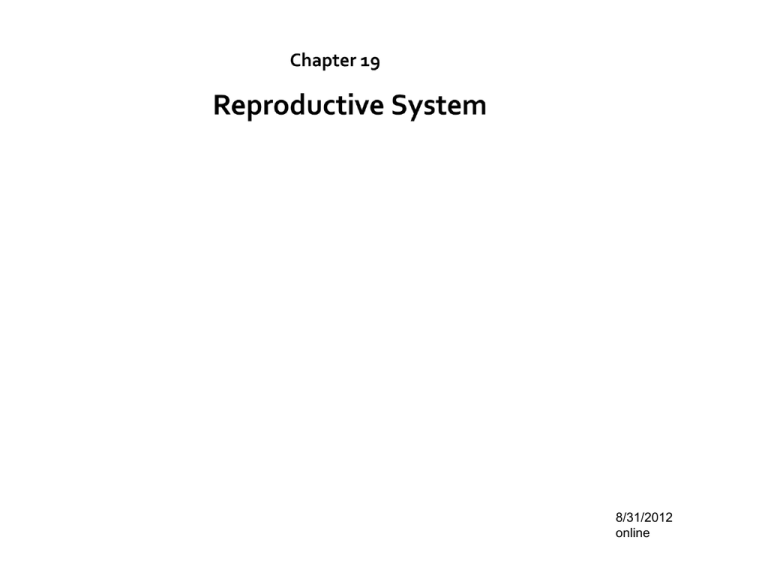
8/31/2012
online
Internal structures of
female reproductive:
Ovaries
Uterine tubes
Uterus
Vagina
Two small, glandular,
organs
Controls menstrual cycle
Contain ova
Ovulation -extrusion of an
ovum by rupture of a
follicle
Pear-shaped muscular organ
Situated in central part of
pelvic cavity
Posterior to urinary bladder
Receives ovum
Serves to house developing fetus
Expels fetus during birth
Consists of four parts:
Fundus
Body
Isthmus
Cervix
Also called fallopian tubes
Collect ova released by
ovaries and convey it to
uterine cavity
3 to 5 long
During implantation,
fertilized ovum, (zygote)
passes into uterine cavity
After 2 weeks, embryo
appears
After 9 weeks, embryo
becomes a fetus
7 months
Connecting cord from the
developing fetus to the
placenta
Provides passage in for
nutrition and removal of
waste
Cord is attached to uterus
via placenta, implanted in
uterine wall
Pt empties bladder prior to
procedure
Pt in lithotomy position
Speculum inserted into vagina
Uterine cannula inserted into
cervical canal
Contrast is administered after
speculum removal
Lies posterior to urinary
bladder and urethra
Muscular structure that
connects uterus to
outside of body
Performs various other
functions
Female – not pregnant (not gravid)
Hysterosalpingography (HSG)
Pelvic pneumonography
Vaginography
Female – pregnant (gravid)
Fetography
Pelvimetry
Fetal cephalometry
Placentagram
Mainly to investigate patency of uterine tubes in pts
unable to conceive
Determine size, shape, and position of uterus and
uterine tubes
Delineate lesions such as polyps, submucousal
tumors, or fistulas
Why should procedure should be scheduled within 10
days following onset of menstruation?
Endometrium is least congested
Least risk of irradiating fertilized ovum
Pt empties bladder prior to
procedure
Pt in lithotomy position
Speculum inserted into vagina
Uterine cannula inserted into
cervical canal
Contrast is administered after
speculum removal
HSG
Shows filling of uterine cavity and bilateral filling of
fallopian tube with injection material
Patency determined by visualization of contrast
Fluoroscopy and/or overheads images
Usually AP, obliques, and lateral
Replaced by
sonography
Study of female
organs by injection of
gas in peritoneal
cavity
Used to investigate
congenital
malformations and
fistulas
Thin barium sulfate
or water-soluble
iodinated contrast
media introduced
into vagina
Radiography of placenta by injecting
radiopaque substance
Shows walls of uterus to locate
placenta in cases of placenta
previa
(In most pregnancies, placenta
is located at the top or side
of uterus. In placenta previa,
placenta is located low in
tuterus)
(Now replaced by ultrasound)
Demonstrates fetus in utero
Detect suspected abnormalities
of development or death
Determine presentation and
position of fetus
Determine number of fetuses
KUB and lateral
Baby enters birth
canal with
buttocks or feet
first as opposed to
normal head first
presentation
Normal
Pelvimetry
(fetal cephalometry)
(Now replaced by Sonography)
Metal ruler to
measure fetal
head’s
relationship to
pelvic outlet
AP and lateral
films
Colcher –Sussman Method
Pelvimetry
External reproductive
structures of male
Penis
Scrotum
Structures enclosed by
scrotal sac
▪
▪
▪
▪
Testes
Epididymides
Spermatic cords
Part of ductus deferens
Bladder
Vesiculogram
Obsolete radiography study
of prostate
Replaced by Sonography

